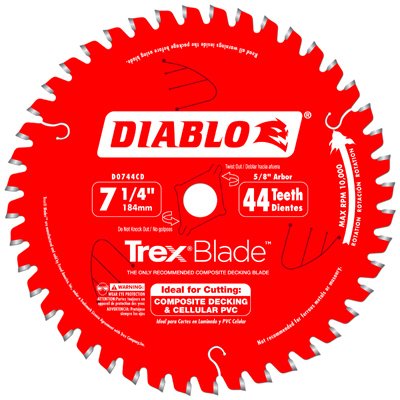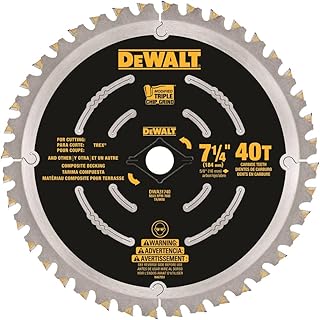Choosing the best saw blade for cutting composite decking can make the difference between a clean, professional finish and a frustrating, uneven cut. Composite boards are tougher than wood, so a standard blade often won’t deliver the results you need. But here’s the good news—you don’t have to guess.
If you’ve already explored the best saw blade for hardwood, you know tooth design and blade durability matter. The same principle applies when evaluating the best mitre saws or even broader categories like the best saws for different projects. Each material requires the right blade to get flawless results.
So, what’s the secret to cutting composite decking cleanly? Let’s break it down.
Top Picks
Best Precision Cut: Diablo TrexBlade Saw Blade for Composites and Plastic - 12" Diameter
The Diablo blade is built with hi-density carbide teeth for long-lasting sharpness and consistent performance. Its 84-tooth design ensures clean, smooth cuts, particularly on composite and fine wood materials. The Perma-SHIELD non-stick coating helps reduce gumming, heat, and corrosion, allowing the blade to stay efficient and reliable over time. With a modern design and lightweight build, it is engineered for precision and durability.
Professionals often value this blade for its ability to deliver smooth, accurate cuts with minimal tear-out, making it a reliable choice for detailed work. Many customers note that the blade runs cooler and cleaner than standard options, though some mention it may not be the best choice for more aggressive or rough cutting needs.
This product provides excellent cutting performance and long-term value for users who prioritize precision and clean finishes. While it may cost more than basic alternatives, its durability and consistent results make it a strong investment for both hobbyists and professionals.
Best Decking Cuts: Diablo TrexBlade Saw Blade for Composites and Plastic - 10" Diameter
The Diablo D1072CD is designed with 72 hi-density carbide teeth, making it ideal for composite decking projects. Its Perma-SHIELD non-stick coating helps prevent heat buildup and reduces gumming, ensuring smoother and longer-lasting performance. With a brushed finish and a solid, sturdy build, this blade provides precision cuts tailored to decking materials while maintaining durability.
Professionals appreciate the specialized design for composite decking, noting that it produces cleaner edges and less chipping compared to general-purpose blades. Customers also highlight its efficiency and ability to maintain sharpness over extended use. However, some point out that it is not as versatile for cutting other materials, which can limit its usefulness outside of decking projects.
This blade excels at what it was built for: composite decking. While it may not be the most flexible option, its precision, durability, and specialized performance make it a reliable choice for contractors and DIY users working with decking materials.
Best for Plastics: Diablo TrexBlade Circular Saw Blade - 10in.
The Diablo D1072CD blade is engineered with 72 teeth, specifically designed to handle PVC and plastics with precision. Its thin 0.1-inch kerf allows for cleaner, more controlled cuts while minimizing material waste. The lightweight build improves handling without sacrificing stability, and the durable construction reflects Diablo’s reputation for quality.
Users appreciate how this blade delivers accurate cuts on plastics and PVC, often noting fewer rough edges compared to standard circular blades. Many also highlight its balance of light weight and strong performance. However, feedback suggests it is not the right choice for tougher materials like hardwood, as it was designed with plastics in mind.
This blade is a dependable option for those working with PVC and plastic materials. While it may not offer versatility across all cutting applications, its efficiency, precision, and durability make it a valuable tool for specialized projects.
FAQs
What saw blade teeth for composite decking?
Composite decking requires a saw blade with fine, evenly spaced teeth to prevent chipping or splintering. Carbide-tipped teeth are preferred because they stay sharp longer and handle the tough plastic-wood blend effectively. A triple-chip grind (TCG) design is especially useful, as it reduces heat buildup and ensures a smoother cut across dense materials.
How many tooth saw blade for composite decking?
For composite decking, a blade with 40 to 60 teeth on a 7 1/4-inch blade or 60 to 80 teeth on a 10- to 12-inch blade is ideal. Too few teeth can cause tearing, while too many may generate excessive heat. The goal is to balance cutting speed with surface smoothness, giving you precise cuts without burning or melting the decking material.
Do you need a special blade to cut composite?
Yes, while you can use a standard wood blade in a pinch, it won’t give the best finish and will wear down quickly. A special composite or non-ferrous metal blade with carbide-tipped teeth provides better results. These blades are designed to handle both the wood fibers and plastic resins in composite boards, extending blade life and improving cut quality.
What do I cut composite decking with?
Composite decking can be cut with common power saws, such as circular saws, miter saws, or table saws, provided they are paired with the right blade. For straight cuts, a circular saw works well. For angled cuts or precise trims, a miter saw is more effective. Always support the decking properly, use a steady feed rate, and allow the blade to do the work without forcing it.
What's the best saw blade for composite decking?
The best saw blade for composite decking is a carbide-tipped blade with a triple-chip grind design and 40 to 60 teeth, depending on blade size. These features minimize chipping, resist heat buildup, and deliver clean, accurate cuts. Popular sizes include 7 1/4-inch blades for handheld saws and 10- to 12-inch blades for miter or table saws. Choosing a high-quality, composite-specific blade ensures both durability and professional results.
Conclusion
Cutting composite decking doesn’t have to be difficult. With the best saw blade for cutting composite decking, you’ll achieve smooth, precise results while protecting both your tools and materials. Remember, the key factors are tooth count, carbide-tipped durability, and TCG design. By matching the right blade to your saw, you’ll save time, extend blade life, and create a polished finish that enhances your decking project.






















